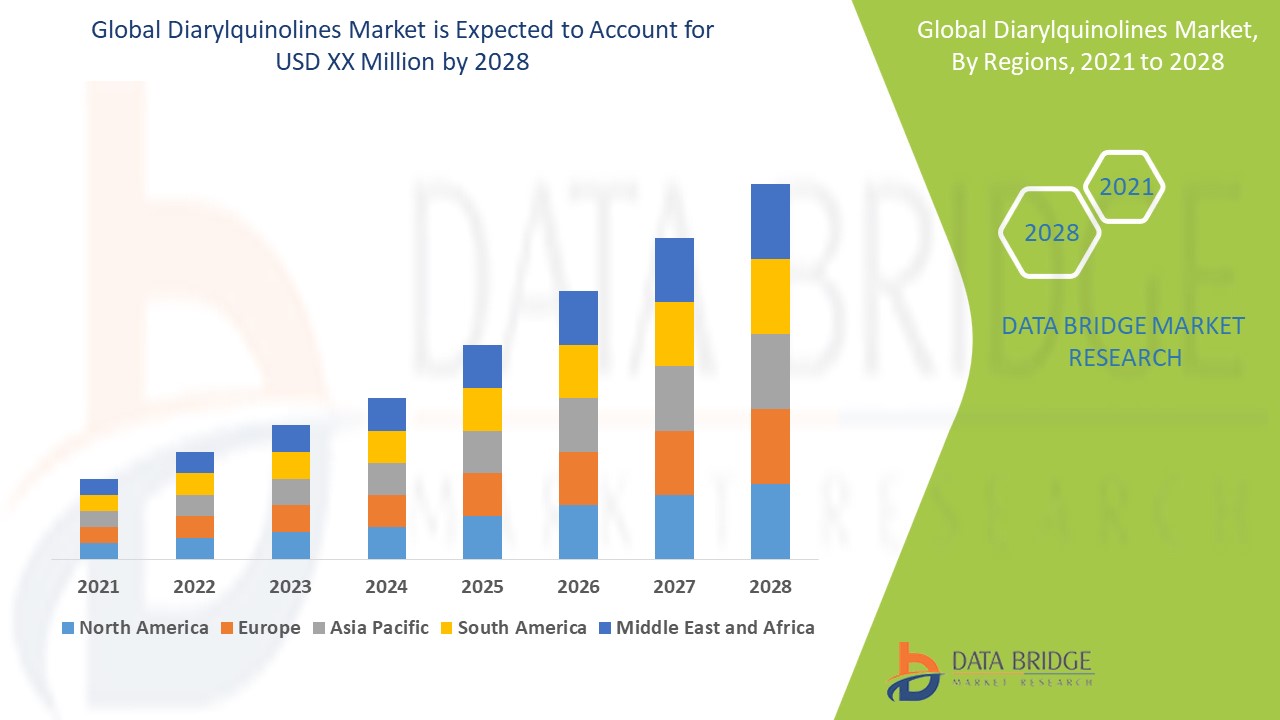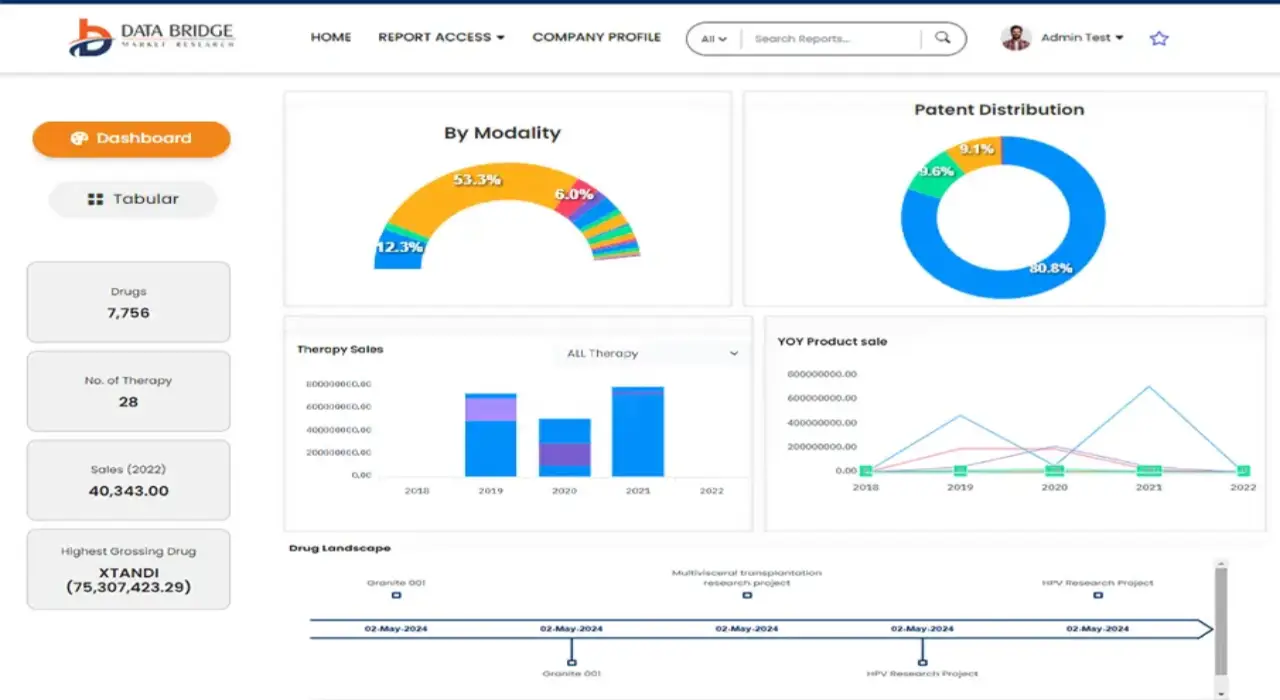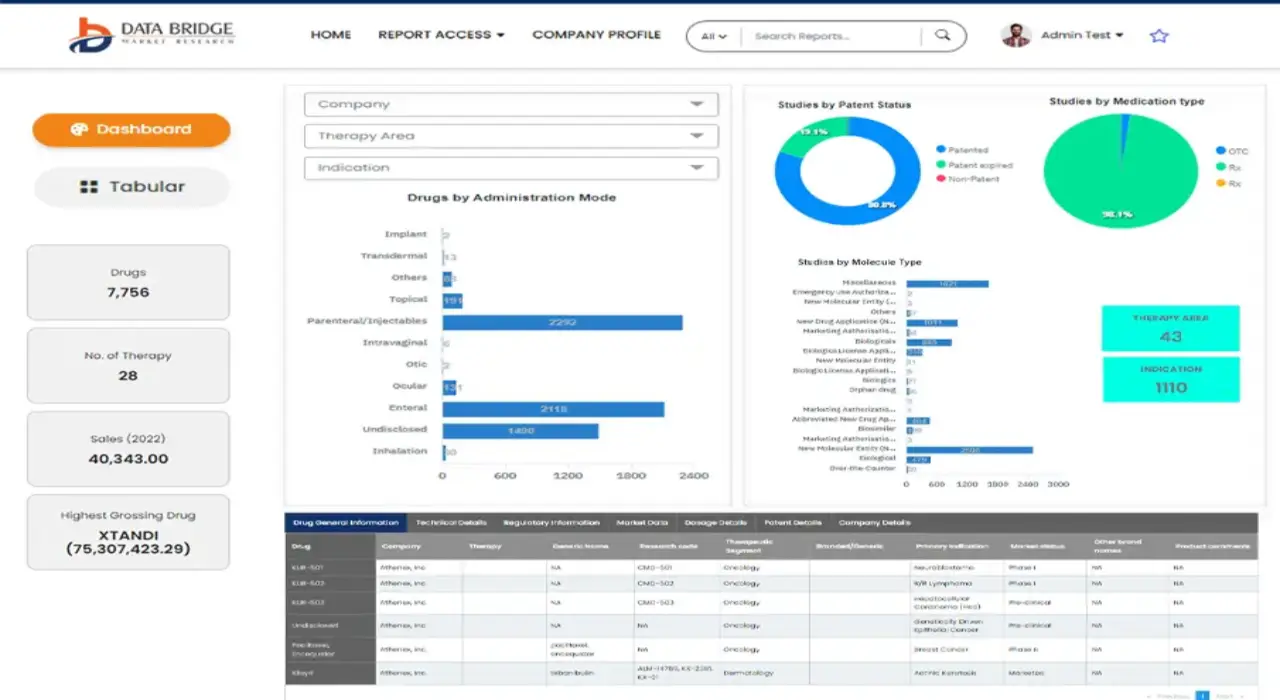Global Diarylquinolines Market
Market Size in USD Million
CAGR :
% 
 USD
151.62 Million
USD
370.34 Million
2024
2032
USD
151.62 Million
USD
370.34 Million
2024
2032
| 2025 –2032 | |
| USD 151.62 Million | |
| USD 370.34 Million | |
|
|
|
|
Global Diarylquinolines Market Segmentation, By Application (Tuberculosis, Anti-Bacterial, and Others), End User (Hospital, Clinics, Ambulatory Surgical Centers, and Others), Distribution Channel (Hospital Pharmacy, Direct Tender, and Online Pharmacy) – Industry Trends and Forecast to 2032
Diarylquinolines Market Analysis
The diarylquinolines market has witnessed significant advancements, particularly in the development of novel compounds with improved pharmacological profiles. The latest method involves the synthesis of optimized diarylquinoline derivatives, targeting various diseases, especially tuberculosis (TB). One such advancement is the development of bedaquiline, a potent diarylquinoline that inhibits the ATP synthase enzyme in Mycobacterium tuberculosis, providing an effective treatment for multidrug-resistant TB. Researchers have focused on enhancing the drug's efficacy, stability, and bioavailability, incorporating nanotechnology and drug delivery systems to improve its clinical performance.
The application of artificial intelligence (AI) and machine learning (ML) in drug discovery has also accelerated the identification of potential diarylquinoline compounds. These technologies allow researchers to predict molecular interactions, thus reducing the time and cost involved in developing new drugs. In addition, advances in biotechnology have improved the synthesis processes of these compounds, making them more scalable for commercial production.
The growth of the diarylquinolines market is driven by rising incidences of TB, especially in low-income countries, and the increasing demand for effective treatments for resistant strains. This growth is further supported by ongoing clinical trials and government initiatives to combat drug-resistant diseases.
Diarylquinolines Market Size
The global diarylquinolines market size was valued at USD 151.62 million in 2024 and is projected to reach USD 370.34 million by 2032, with a CAGR of 12.5% during the forecast period of 2025 to 2032. In addition to the insights on market scenarios such as market value, growth rate, segmentation, geographical coverage, and major players, the market reports curated by the Data Bridge Market Research also include depth expert analysis, patient epidemiology, pipeline analysis, pricing analysis, and regulatory framework.
Diarylquinolines Market Trends
“Rising Demand for Antimicrobial Drug Development in the Diarylquinolines Market”
One key trend fueling the growth of the diarylquinolines market is the increasing demand for novel antimicrobial agents. Diarylquinolines are gaining traction due to their effectiveness against drug-resistant bacterial infections. A notable instance is the use of diarylquinoline-based drugs such as Bedaquiline, which is specifically developed for the treatment of multi-drug-resistant tuberculosis (MDR-TB). The need for new antibiotics and treatments to combat antibiotic resistance has spurred significant investment in the research and development of diarylquinolines. This trend is particularly evident in regions with high tuberculosis rates, such as India and sub-Saharan Africa, further driving the market's expansion.
Report Scope and Diarylquinolines Market Segmentation
|
Attributes |
Diarylquinolines Key Market Insights |
|
Segments Covered |
|
|
Countries Covered |
U.S., Canada and Mexico in North America, Germany, France, U.K., Netherlands, Switzerland, Belgium, Russia, Italy, Spain, Turkey, Rest of Europe in Europe, China, Japan, India, South Korea, Singapore, Malaysia, Australia, Thailand, Indonesia, Philippines, Rest of Asia-Pacific (APAC) in the Asia-Pacific (APAC), Saudi Arabia, U.A.E, South Africa, Egypt, Israel, Rest of Middle East and Africa (MEA) as a part of Middle East and Africa (MEA), Brazil, Argentina and Rest of South America as part of South America |
|
Key Market Players |
Thermo Fisher Scientific (U.S.), Merck KGaA (Germany), Bioline Reagents Limited (U.K.), Dnavision (Belgium), Eppendorf AG (Germany), Neurim Pharmaceuticals (Israel), Actuate Therapeutics Inc (U.S.), DiaMedica Therapeutics Inc (U.S.), Angelini Group (Italy), Jeil Pharmaceutical Co Ltd (South Korea), and AMO Pharma Ltd (U.K.) |
|
Market Opportunities |
|
|
Value Added Data Infosets |
In addition to the insights on market scenarios such as market value, growth rate, segmentation, geographical coverage, and major players, the market reports curated by the Data Bridge Market Research also include depth expert analysis, patient epidemiology, pipeline analysis, pricing analysis, and regulatory framework. |
Diarylquinolines Market Definition
Diarylquinolines are a class of organic compounds featuring a quinoline structure with two aromatic rings attached to the nitrogen-containing quinoline backbone. These compounds have gained attention due to their biological activity, particularly as potential antitubercular agents. Diarylquinolines inhibit the ATP synthase enzyme in Mycobacterium tuberculosis, making them effective against tuberculosis (TB). The most notable diarylquinoline is bedaquiline, approved by the FDA for multidrug-resistant tuberculosis treatment. These compounds are also studied for their potential in combating other diseases, including cancer and parasitic infections, due to their ability to interfere with cellular processes. Research continues to explore their broader therapeutic applications.
Diarylquinolines Market Dynamics
Drivers
- Growing Demand for Antibiotics
The growing demand for antibiotics, driven by the increasing prevalence of antibiotic-resistant infections, significantly impacts the diarylquinolines market. As bacterial resistance to traditional antibiotics continues to rise, the need for innovative treatments becomes more critical. Diarylquinolines, such as bedaquiline, have emerged as promising solutions due to their effectiveness against resistant strains of diseases such as tuberculosis (TB). For instance, bedaquiline has proven to be a game-changer in treating multidrug-resistant TB, where conventional treatments often fail. As the global health community focuses on combating drug-resistant infections, the demand for novel antimicrobial agents such as diarylquinolines is expected to increase, further driving the market's growth.
- Rising Incidence of Tuberculosis (TB)
The rising incidence of tuberculosis (TB), particularly multidrug-resistant (MDR) TB, is a key driver for the diarylquinolines market. Bedaquiline, a diarylquinoline, has become a vital treatment option for MDR-TB, especially in cases where conventional antibiotics fail. The World Health Organization (WHO) has endorsed bedaquiline as part of its regimen for treating drug-resistant TB. With TB rates climbing, especially in developing countries such as India and China, the demand for effective treatments is growing. In 2021, approximately 10 million people contracted TB, with a significant number facing resistance to first-line drugs. This rising burden drives the adoption of innovative drugs such as bedaquiline, thereby propelling the growth of the diarylquinolines market.
Opportunities
- Advancements in Drug Development
Ongoing research and clinical trials on diarylquinolines are creating significant opportunities in the market by expanding their therapeutic applications. For instance, the development of bedaquiline, a diarylquinoline, has proven to be a breakthrough in the treatment of multidrug-resistant tuberculosis (MDR-TB). As clinical trials continue, diarylquinolines are being explored for treating other infectious diseases, such as leprosy and certain fungal infections. In addition, research into improving the drug’s efficacy and minimizing side effects is driving further demand. This progress in drug development not only enhances the clinical value of diarylquinolines but also attracts investments, leading to a growing market for these innovative treatments.
- Increase in Chronic Respiratory Diseases
The global rise in chronic respiratory diseases (CRDs), such as chronic obstructive pulmonary disease (COPD) and asthma, is creating significant opportunities in the diarylquinolines market. These conditions often lead to bacterial infections that require advanced treatments such as diarylquinolines, particularly for managing resistant infections. For instance, the increased prevalence of multidrug-resistant tuberculosis (MDR-TB) among CRD patients has led to the greater use of diarylquinolines such as bedaquiline in TB treatment regimens. As the burden of respiratory diseases continues to grow, there is a rising demand for novel, effective drugs to combat the associated infections, which is driving the market for diarylquinolines as a key treatment option.
Restraints/Challenges
- High Production Costs
High production costs are a significant restraint in the diarylquinolines market. The synthesis of these compounds involves intricate chemical processes, which require specialized equipment and skilled labor, contributing to the overall cost. In addition, the need for high-quality raw materials further elevates production expenses. These high costs translate into higher prices for end products, limiting their affordability and accessibility. As a result, diarylquinolines may not be competitive compared to other treatments in the market. This pricing challenge can discourage widespread adoption, particularly in price-sensitive regions or among healthcare providers with limited budgets, ultimately hindering market growth and limiting the potential for widespread use.
- Side Effects and Safety Concerns
Side effects and safety concerns significantly hinder the diarylquinolines market. These compounds, while effective in certain therapeutic areas, have been associated with adverse effects such as liver toxicity, gastrointestinal disturbances, and cardiovascular issues. The risk of such side effects poses challenges for their use, particularly in vulnerable patient populations, including those with pre-existing conditions. As a result, healthcare professionals may be cautious in prescribing diarylquinolines, limiting their adoption. In addition, the need for extensive clinical trials to assess safety further delays their approval and market penetration. The growing concerns over the safety profile of these compounds may deter pharmaceutical companies from pursuing further development, hindering market growth.
This market report provides details of new recent developments, trade regulations, import-export analysis, production analysis, value chain optimization, market share, impact of domestic and localized market players, analyses opportunities in terms of emerging revenue pockets, changes in market regulations, strategic market growth analysis, market size, category market growths, application niches and dominance, product approvals, product launches, geographic expansions, technological innovations in the market. To gain more info on the market contact Data Bridge Market Research for an Analyst Brief, our team will help you take an informed market decision to achieve market growth.
Diarylquinolines Market Scope
The market is segmented on the basis of category, form, product type, and end user. The growth amongst these segments will help you analyze meagre growth segments in the industries and provide the users with a valuable market overview and market insights to help them make strategic decisions for identifying core market applications.
Application
- Tuberculosis
- Anti-Bacterial
- Others
End User
- Hospital
- Clinics
- Ambulatory Surgical Centers
- Others
Distribution Channel
- Hospital Pharmacy
- Direct Tender
- Online Pharmacy
Diarylquinolines Market Regional Analysis
The market is analysed and market size insights and trends are provided by country, category, form, product type, and end user as referenced above.
The countries covered in the market report are U.S., Canada, Mexico in North America, Germany, Sweden, Poland, Denmark, Italy, U.K., France, Spain, Netherland, Belgium, Switzerland, Turkey, Russia, Rest of Europe in Europe, Japan, China, India, South Korea, New Zealand, Vietnam, Australia, Singapore, Malaysia, Thailand, Indonesia, Philippines, Rest of Asia-Pacific (APAC) in Asia-Pacific (APAC), Brazil, Argentina, Rest of South America as a part of South America, U.A.E, Saudi Arabia, Oman, Qatar, Kuwait, South Africa, Rest of Middle East and Africa (MEA) as a part of Middle East and Africa (MEA)
Asia Pacific is expected to dominate the diarylquinolines market due to the increasing prevalence of tuberculosis (TB) in the region. As TB cases rise, the demand for effective treatments, such as diarylquinolines, continues to grow. In addition, expanding healthcare infrastructure and rising awareness contribute to the market's growth in this region.
North America is expected to account for the largest market share in the diarylquinolines market due to increasing public awareness of healthcare issues and rising healthcare expenditures. The growing adoption of advanced treatments for diseases, alongside government investments in healthcare infrastructure, is driving the demand for diarylquinolines in the region.
The country section of the report also provides individual market impacting factors and changes in regulation in the market domestically that impacts the current and future trends of the market. Data points such as down-stream and upstream value chain analysis, technical trends and porter's five forces analysis, case studies are some of the pointers used to forecast the market scenario for individual countries. Also, the presence and availability of global brands and their challenges faced due to large or scarce competition from local and domestic brands, impact of domestic tariffs and trade routes are considered while providing forecast analysis of the country data.
Diarylquinolines Market Share
The market competitive landscape provides details by competitor. Details included are company overview, company financials, revenue generated, market potential, investment in research and development, new market initiatives, global presence, production sites and facilities, production capacities, company strengths and weaknesses, product launch, product width and breadth, application dominance. The above data points provided are only related to the companies' focus related to market.
Diarylquinolines Market Leaders Operating in the Market Are:
- Thermo Fisher Scientific (U.S.)
- Merck KGaA (Germany)
- Bioline Reagents Limited (U.K.)
- Dnavision (Belgium)
- Eppendorf AG (Germany)
- Neurim Pharmaceuticals (Israel)
- Actuate Therapeutics Inc (U.S.)
- DiaMedica Therapeutics Inc (U.S.)
- Angelini Group (Italy)
- Jeil Pharmaceutical Co Ltd (South Korea)
- AMO Pharma Ltd (U.K.)
SKU-
Get online access to the report on the World's First Market Intelligence Cloud
- Interactive Data Analysis Dashboard
- Company Analysis Dashboard for high growth potential opportunities
- Research Analyst Access for customization & queries
- Competitor Analysis with Interactive dashboard
- Latest News, Updates & Trend analysis
- Harness the Power of Benchmark Analysis for Comprehensive Competitor Tracking
Research Methodology
Data collection and base year analysis are done using data collection modules with large sample sizes. The stage includes obtaining market information or related data through various sources and strategies. It includes examining and planning all the data acquired from the past in advance. It likewise envelops the examination of information inconsistencies seen across different information sources. The market data is analysed and estimated using market statistical and coherent models. Also, market share analysis and key trend analysis are the major success factors in the market report. To know more, please request an analyst call or drop down your inquiry.
The key research methodology used by DBMR research team is data triangulation which involves data mining, analysis of the impact of data variables on the market and primary (industry expert) validation. Data models include Vendor Positioning Grid, Market Time Line Analysis, Market Overview and Guide, Company Positioning Grid, Patent Analysis, Pricing Analysis, Company Market Share Analysis, Standards of Measurement, Global versus Regional and Vendor Share Analysis. To know more about the research methodology, drop in an inquiry to speak to our industry experts.
Customization Available
Data Bridge Market Research is a leader in advanced formative research. We take pride in servicing our existing and new customers with data and analysis that match and suits their goal. The report can be customized to include price trend analysis of target brands understanding the market for additional countries (ask for the list of countries), clinical trial results data, literature review, refurbished market and product base analysis. Market analysis of target competitors can be analyzed from technology-based analysis to market portfolio strategies. We can add as many competitors that you require data about in the format and data style you are looking for. Our team of analysts can also provide you data in crude raw excel files pivot tables (Fact book) or can assist you in creating presentations from the data sets available in the report.













